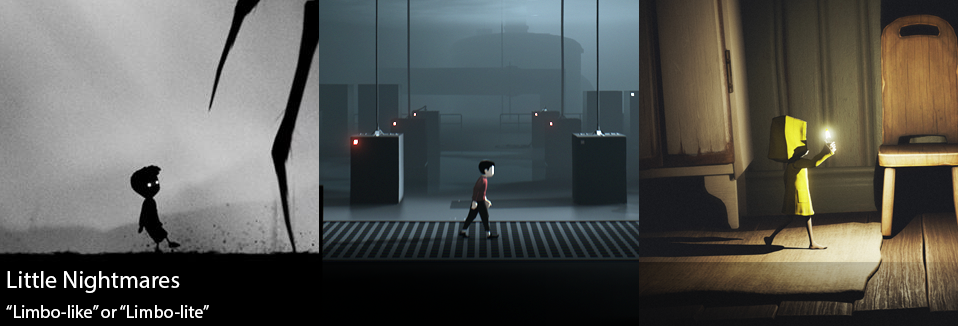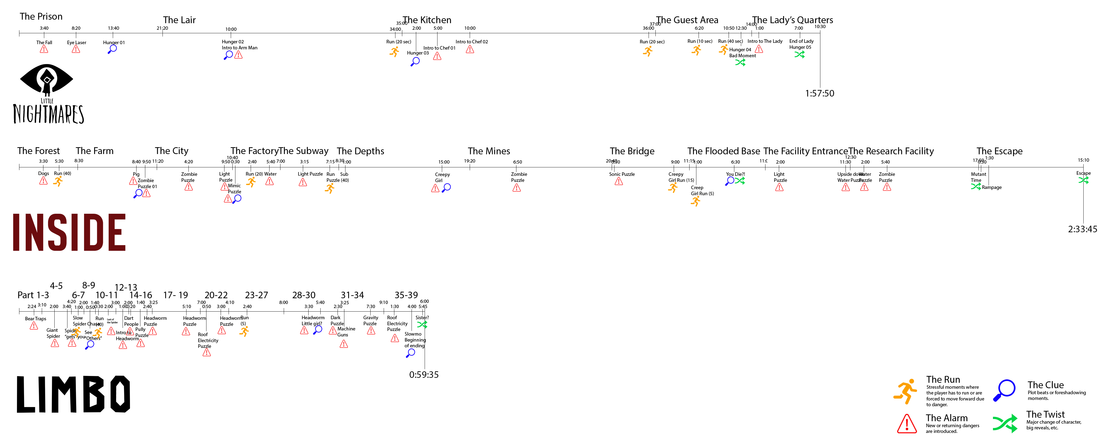|
|
Personal Projects
|
|
|
Little Nightmares is a game that follows a similar pattern in gaming that we’ve seen since 2010, if not longer. After having done a recent post on “Rogue-like” games, I can’t help but think there should a term that describes games like Limbo, Inside, and Little Nightmares. In today’s post I’m going to mainly be discussing Little Nightmares, but also it’s similarities to other games in the same family. I’ll avoid full on spoilers, but I will hint HEAVILY on the plot of these games… so you’ve been warned! Let me start by saying that while playing Little Nightmares, I had little to no clue what the actual plot was. I had a vague idea what was happening, but after doing some research… I realize how little I actually knew. For instance, I had no clue that my character’s name was “Six,” which I can only imagine has a lot of different plot implications. In any case the story of Little Nightmares is centered around a girl named Six who is trapped in a place called “The Maw.” As the wiki describes it, the Maw is “a surreal resort catering to the whims of sick and powerful creatures.” Hunger is a pretty large theme in the game, as it’s implied that these “powerful creatures” are potentially trapping and eating small children. Not to mention that in late game missions they are seen as the epitome of gluttony as they are forcing food into their face. Six also struggles with hunger as she tries to make her escape, and there are several moments within the game where she’s weakened by this and has to find something to eat. The core of the game is about exploration, avoiding these large monsters, some slight puzzle solving, and trying to get out. I did sort of a deep dive in my exploration of main themes between Little Nightmares, Inside, and Limbo and found four common criteria I could use to compare these three games:  “The Run” Stressful moments where the player has to run or are forced to move forward due to danger.  “The Alarm” New or returning dangers are introduced.  “The Clue” Plot beats or foreshadowing moments.  “The Twist” Major change of character, big reveals, etc. From here I used walkthroughs to begin mapping out these key events in the three different games. I’ve tried to be as accurate as possible but I’m sure there are some discrepancies in my exact timing of events. Below you can see my findings based off of these criteria :
There are a few things that I found interesting while going through this process. Namely the differences in how the games divide themselves. Little Nightmares has 5 clearly distinct chapters with an obvious flow implied. Inside actually has 12 parts, relies heavily on puzzle variety, and leaves little hints as to the game’s ending along the way. Limbo is a tightly packed sprint of puzzles and events, yet is divided into 39 parts! Each of these parts can last quickly as 30 seconds if you know what you’re doing. As I see it, Limbo is the most puzzle driven of the three, Little Nightmares is the most narrative driven, with Inside in the middle but slightly leaning more towards puzzle content. I expected to see more rhythm or clear intent to these key events among these games, yet I think we can see the intent pretty clearly with Little Nightmares. There’s three evenly spaced narrative beats, each time getting more darker for our protagonist, before a main twist moment and then sprint to the end. I also found it interesting that running moments were often at the end of a chapter, kind of closing it out. I think the way these key moments are spaced out we can see the rise in tension within the game, climax within the Guest Area, and then conclusion. Whereas Inside is a bit more of a slow burn, with fast moments, until a major twist and then free for all rampage ending. I went into this exploration wanting to find the similarities between these games, and ironically enough I found the differences. While these games maintain similar mechanics, protagonists, and overall mood... The game play intention varies between these games. Is this an argument to say that these games don't belong in the same family? I don't think so. Similarly to my post about survival games (Survival games and Survival Games 2), I compared games of the same genre and isolated how they modify their mechanics for different driving factors for players. This is thematically similar, sort of on the spectrum of puzzle gaming vs story. I'm not completely positive that we can start defining these as "Limbo-like," there may be other games that fit within this criteria that even pre-date Limbo that I haven't considered... Yet I think it's an interesting gaming trend that I hope to see more of it. I'm keeping this one relatively brief, even with all of the research work I put in on this one. I hope that this was interesting! I've been wanting to do an analysis like this for quite some time, and have even considered doing this on some horror games... to compare the beats... Yet these games were short enough that I was able to compile this data relatively easily. In any case if you haven't picked up Little Nightmares yet, I highly recommend it! It's a pretty great gaming experience. Also I'm happy to see that I'm not the only one feeling the strong Coraline Vibes :
2 Comments
|
AuthorI make games, I play games... and sometimes I have some thoughts about that. Archives
March 2024
|
||||||
Proudly powered by Weebly















 RSS Feed
RSS Feed